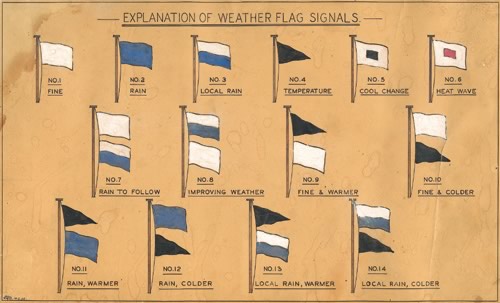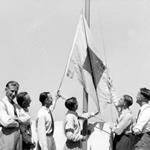Flagging a reliable system for early weather watchers
19 June 2012
Weather forecasting has always been an inventive art. No more so than during the 1930s, when a young messenger named Tom Hall would scale the roof of the Bureau's headquarters in Carlton, Melbourne, each morning to run up a series of flags denoting the day's weather.
The system of nautical-style flags was launched in late 1911—less than four years after the Bureau's formation—by Commonwealth Meteorologist, Henry A. Hunt, who would personally issue the forecast according to the day's meteorological bulletin. When he retired in 1931, Hunt's forecast 'strike rate' was estimated at an impressive 87 per cent.
Weather flags were arguably Australia's first 'real-time' weather warning system, which also included weather maps in most daily newspapers. As well as at Bureau offices in state capitals, flags were flown from the roofs of post offices, customs houses, and major newspaper offices.
Based upon an international standard pioneered in the United States, the system used a combination of six flags to signal various weather types, from fine conditions to rain, rising or falling temperatures to cool changes, or—with a prominent inner red square—heat waves.
Bureau offices would wire the day's forecast to participating buildings by 10 am each morning, with instructions as to which flags were to be hoisted and the order in which they should appear on their masts.
Cards explaining the combinations and juxtapositions of flags were made available to the public through post offices, shops and other buildings where weather forecasts were usually displayed.

Chart explaining weather flag signals that indicate the day's weather.
Weather flags were intended to promote public use of the Bureau's forecasting services—and to reduce reliance on folklore and unofficial forecasters who often charged fees for less reliable predictions.
When they were phased out in the late 1940s, the flags left a gap in tall-building weather warning systems that was eventually replaced by weather beacons—used most prominently during the 1950s and '60s to signal local weather in a code of coloured or flashing lights.


Comment. Tell us what you think of this article.
Share. Tell others.